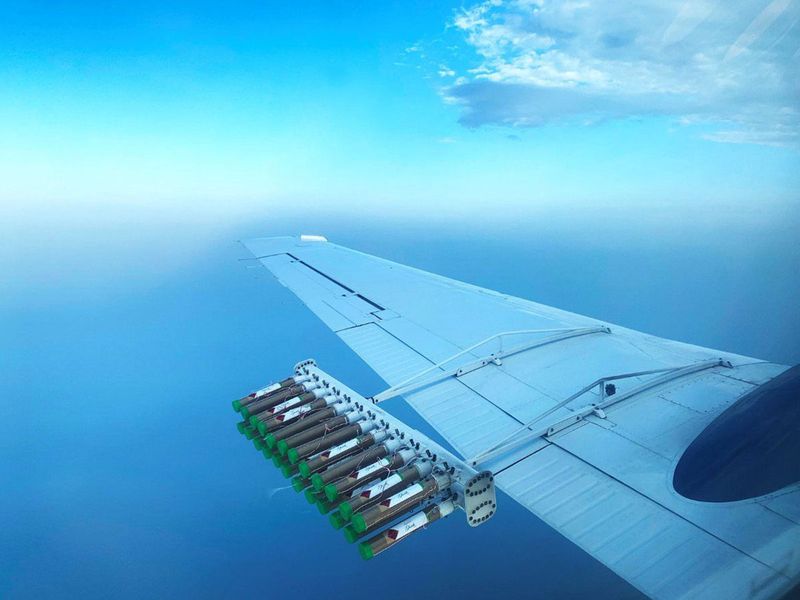Official clears air on impact of cloud seeding on recent rains in UAE
Abu Dhabi
The UAE may have seen one its heaviest bouts of rainfall this month, but cloud seeding would only have increased the amount of rainfall by up to 35 per cent, a top meteorology expert told Gulf News on Sunday.
“There is [still] no technology to measure the cloud seeding results precisely, so I cannot tell you how much a cloud will rain on its own and how much seeding will help [increase precipitation]. But cloud seeding gives 30 to 35 per cent increase in precipitation, and we try to get the maximum amount,” said Omar Al Yazeedi, director of research, development and training at the UAE’s weather bureau, the National Centre of Meteorology (NCM).
Omar Al Yazeedi, director of research, development and training, National Centre of Meteorology
He was speaking on the sidelines of the fourth International Rain Enhancement Forum in the capital, where environmental experts met to discuss the science of rain and global water security.
Rain enhancement programme
The UAE launched its research programme for rain enhancement science in 2015, and has so far granted a total of $15 million (Dh55 million) to nine projects. Some of these have helped advance rain science, while others have focused on improving seeding materials and weather monitoring.
What we do with seeding is we put these salt particles, which are a good absorbent of moisture. The particles make the droplets grow in size, they collide together and form a bigger droplet that is heavier than air, and it falls as rain
– Omar Al Yazeedi, director of research, development and training, National Centre of Meteorology
According to the NCM, the UAE saw just 46.5 millimetres of rainfall in 2018, even though 184 cloud seeding operations were carried out. In 2019, rainfall increased to 101.1 millimetres, with 247 operations undertaken. And this year, the NCM has already carried out 17 seeding operations.
‘We do not create clouds’
Al Yazeedi said cloud seeding continues throughout year, with rainfall occurring in the mountains, in Al Ain, Ras Al Khaimah and parts of Sharjah. The NCM has a hangar in Al Ain with four aircraft, and the teams are on standby whenever there is a forecast for cumulus cloud formation.

The official, however, debunked the myth that the NCM creates clouds, and thereby contributes to storms.
“If we do not have clouds, we cannot do seeding. So people think that we make clouds, we are making storms. But we are not. We are just helping the clouds to precipitate more,” Al Yazeedi said.
Advancing rain science
This enhancement in precipitation levels helps reduce temperatures, thereby mitigating climate change.
In addition, the UAE aims to advance the science for rain enhancement. The country has been performing cloud seeding since the late 1980s, but the understanding of rain science has remained fairly stagnant since then, Al Yazeedi said.

“Our ultimate goal is to move science forward. We need solutions to the problem [of low rainfall]. The same science used 60 years ago was still in use when this programme was launched, and there is a need to advance it. We are therefore trying to help scientists by providing them tools, funds, access to radar data, aircraft and technologies so they can continue their studies,” he explained.
Enhancing water supply
Rain enhancement is seen as offering a cost-effective and sustainable solution to recharging the country’s groundwater levels. This aquifer increase is also a better, less environmentally-damaging approach to increasing water supply than desalination.
The eventual goal of the NCM’s rain enhancement research is to try and form clouds, something that has not yet been done.EFFECTIVE SEEDINGWhen there is a forecast for cumulus clouds – flat-based, puffy clouds that often have water content – the NCM sends out its aircraft for seeding. The window for seeding to be effective is short – just 20-30 minutes
“[Cloud formation] requires massive energy. You cannot control [this mass of energy yet] or move it,” Al Yazeedi said.
The authority is also looking at solutions for more arid regions of the UAE, where there are no wadis or mountains to contribute to rainfall.
Asked about improving the UAE’s infrastructure to manage the increases in rainfall, Al Yazeedi said there is a continual need for advancing infrastructure everywhere.
“Our duty at the NCM is to monitor rainfall, and enhance precipitation. But we work with the relevant ministries [who manage infrastructure],” he said.
How is cloud seeding done?
The National Centre of Meteorology, the UAE’s weather bureau, has a hangar in Al Ain with four aircraft.

When there is a forecast for cumulus clouds – flat-based, puffy clouds that often have water content – the NCM sends out its aircraft for seeding. According to Omar Al Yazeedi, director of research, development and training at the NCM, there is a very short window for seeding to be effective.
“We have 20 to 30 minutes only. That’s why we moved our operations from Abu Dhabi to Al Ain because it is closer to the mountains, where local weather systems cause clouds to form,” Al Yazeedi said.
The aircraft fire hygroscopic flares with seeding materials, usually a mixture of salts, into the clouds.

“Cumulus clouds have water but sometimes the droplets are too tiny. [So even if ] the vertical wind energy within carries the tiny water droplets, they cannot reach the ground, or they fall as rain but evaporate before reaching the ground. What we do with seeding is we put these salt particles, which are a good absorbent of moisture. The particles make the droplets grow in size, they collide together and form a bigger droplet that is heavier than air, and it falls as rain,” Al Yazeedi explained.
Cloud seeding has been proven to change the structure of the droplet in the cloud to form bigger droplets which are also better distributed at the base of the cloud.
According to Al Yazeedi, clear air, good updraft (vertical wind energy in the cloud) and a seeding operation in the early stages of cloud formation helps improve the effectiveness of cloud seeding.


